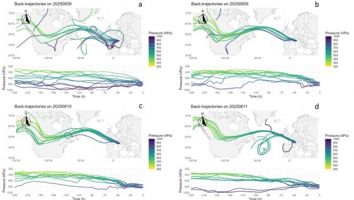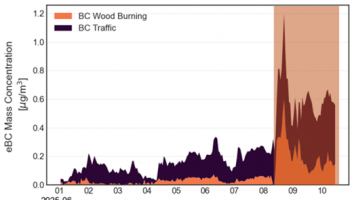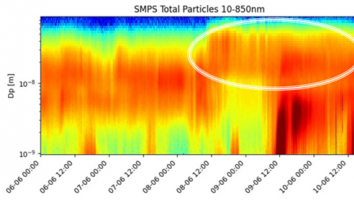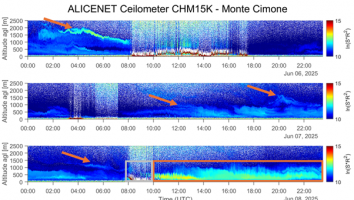
In May and June 2025, extensive wildfires in Canada forced the evacuation of thousands of people. However, the consequences of these events extended far beyond North America: a large plume of atmospheric pollutants crossed the Atlantic Ocean and reached Europe, as confirmed by the Copernicus Atmosphere Monitoring Service (CAMS) of the European Copernicus Programme.
One of the clearest indicators of this phenomenon was recorded on the morning of June 8, 2025, at the CNR Climate Observatory on Monte Cimone. On that day, a sharp increase was observed in several atmospheric pollutants associated with biomass combustion—particularly airborne particulate matter, carbon monoxide (CO), and ozone (O₃). Atmospheric transport models, together with direct observation of dense haze, confirmed the Canadian origin of these air masses at high altitude.
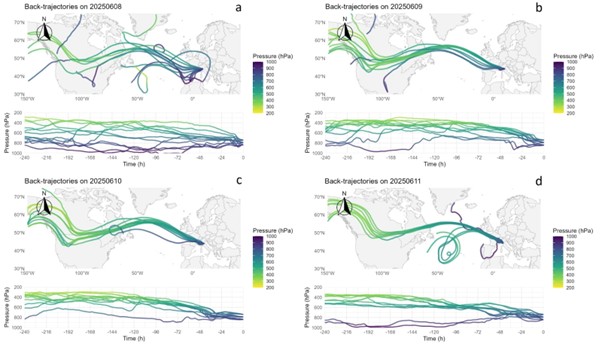
Back trajectories of air masses reaching Monte Cimone in the period of June 8 - 11 2025, calculated by LAGRANTO model (Sprenger and Wernli, 2015) by using ECMWF data.

A picture taken on June 10 at 8:00 AM from the summit of Monte Cimone toward the Po Valley clearly shows the presence of haze attributable to the smoke plume originating from Canada.
Concentrations of fine particulate matter, particularly black carbon (BC), were found to be especially high. Black carbon, produced by the incomplete combustion of biomass, is known for its ability to absorb solar radiation, thereby contributing to atmospheric warming as a positive radiative forcing agent. The observed values (locally >1 µg/m³) significantly exceeded the typical levels recorded at this altitude.
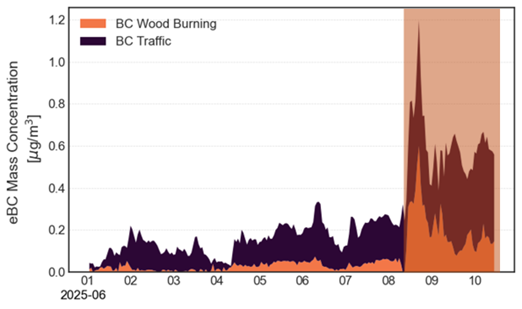
Mass values of equivalent black carbon observed at Monte Cimone during the period June 1–10, 2025. The orange section represents the contribution associated with biomass combustion.
Multi-wavelenght analysis of aerosol absorption (equivalent black carbon) made possible to distinguish between different emission sources, separating contributions from liquid fuels (such as fossil fuels, typical of urban traffic) and those associated with solid fuels (such as wood, characteristic of biomass combustion). Data recorded on June 8, 2025, showed a marked increase in BC concentrations, with values more than doubling compared to the average of the preceding days. This increase was primarily attributed to biomass combustion, reinforcing the direct link to the widespread wildfires active in Canada.
Even in the following days, June 9 and 10, despite atmospheric circulation models suggesting a mixing of Canadian air masses with those containing European emissions, the contribution from biomass remained significant—confirming the persistence of long-range transport of pollutants originating from North American wildfires.
The observed aerosol particles number size distribution shows an additional and persistent accumulation mode (ranging between 100 nm and 1 µm), suggesting that aerosol particles were modified by aging processes and grew during their long transatlantic journey. The observed shift in particle size, compared to smaller “fresh” particles, indicates that these aerosols experienced chemical and physical transformations during long-range transport.
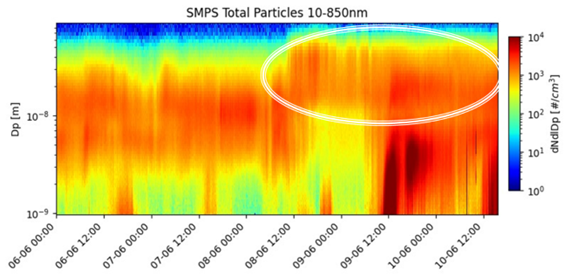
Number of particles (color scale) as a function of diameter (y-axis) during the period June 6–10, 2025. The white ellipse indicates particles attributable to biomass combustion
The impact of the wildfires was also detectable in the gaseous composition of the atmosphere. Carbon monoxide registered average values of 204 ppb starting from 6:00 AM on June 8, approximately double the levels recorded in the preceding days. Ozone—which is not directly emitted by the fires but forms through photochemical reactions among emitted gases—also showed an increase of 30%, confirming the influence of the incoming smoke.
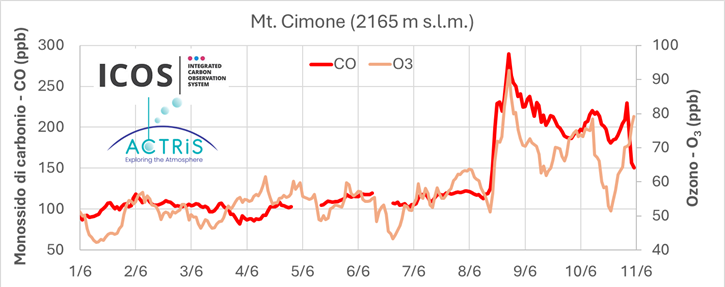
CO values (left y-axis) and O₃ values (right y-axis) at Monte Cimone during the period June 1–10, 2025. A sudden increase in these compounds starting from June 8 is clearly evident.
An additional piece of evidence came from observations made using the ceilometer of the ALICE-Net infrastructure. This instrument monitored, between June 6 and 8, the presence of aerosol-rich atmospheric layers at high altitude, well before they reached the surface of Monte Cimone. The ceilometer signal showed the gradual arrival of the plume, visible as filamentous layers with medium to high values consistent with combustion aerosols.
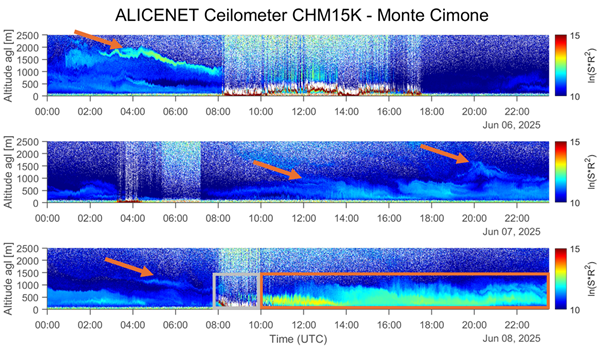
Backscatter values (color scale) observed at Monte Cimone on June 6, 7, and 8, 2025, using the ceilometer. The y-axis represents altitude in the atmosphere (in meters above the summit of Monte Cimone).
On June 6, an initial layer was detected between 1500 and 2000 meters above the summit (approximately 3600–4100 meters above sea level), with a strong signal intensity. The following day, dense particulate layers were observed, albeit at lower altitudes. On June 8, the phenomenon exhibited particularly interesting dynamics: observations recorded a gradual lowering of the particulate layers until they reached the ground.
Although further analyses are ongoing to precisely determine the contribution of other processes, all collected evidence—chemical, optical, and physical—indicates that on June 8, 2025, the wildfires in Canada had a direct and measurable impact on atmospheric composition thousands of kilometers away, influencing the atmospheric content of pollutants and climate-altering substances.

